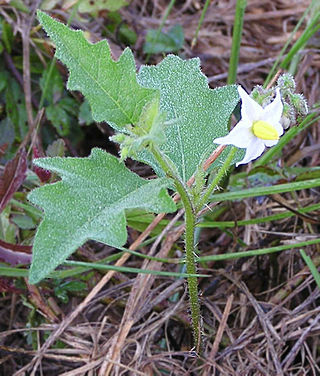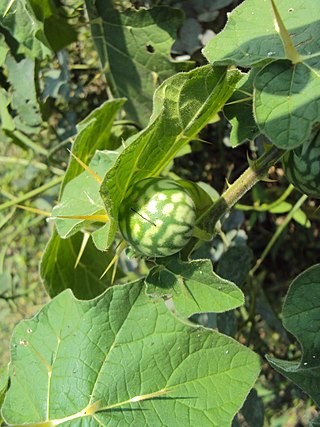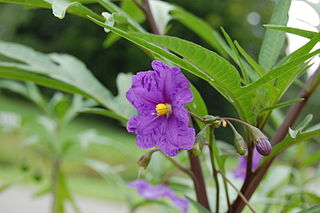
The potato is a starchy tuberous vegetable native to the Americas that is consumed as a staple food in many parts of the world. Potatoes are underground tubers of the plant Solanum tuberosum, a perennial in the nightshade family Solanaceae.

Solanum is a large and diverse genus of flowering plants, which include three food crops of high economic importance: the potato, the tomato and the eggplant. It is the largest genus in the nightshade family Solanaceae, comprising around 1,500 species. It also contains the so-called horse nettles, as well as numerous plants cultivated for their ornamental flowers and fruit.

Solanum carolinense, the Carolina horsenettle, is not a true nettle, but a member of the Solanaceae, or nightshade family. It is a perennial herbaceous plant, native to the southeastern United States, though its range has expanded throughout much of temperate North America. The plant is an invasive in parts of Europe, Asia, Africa and Australia. The stem and undersides of larger leaf veins are covered with prickles.

Solanum dulcamara is a species of vine in the genus Solanum of the family Solanaceae. Common names include bittersweet, bittersweet nightshade, bitter nightshade, blue bindweed, Amara Dulcis, climbing nightshade, felonwort, fellenwort, felonwood, poisonberry, poisonflower, scarlet berry, snakeberry, trailing bittersweet, trailing nightshade, violet bloom, and woody nightshade.

Solanine is a glycoalkaloid poison found in species of the nightshade family within the genus Solanum, such as the potato. It can occur naturally in any part of the plant, including the leaves, fruit, and tubers. Solanine has pesticidal properties, and it is one of the plant's natural defenses. Solanine was first isolated in 1820 from the berries of the European black nightshade, after which it was named. It belongs to the chemical family of saponins.

Apios americana, sometimes called the American groundnut, potato bean, hopniss, Indian potato, hodoimo, America-hodoimo, cinnamon vine, or groundnut is a perennial vine that bears edible beans and large edible tubers.

Solanum americanum, commonly known as American black nightshade, small-flowered nightshade or glossy nightshade, is a herbaceous flowering plant of wide though uncertain native range. The certain native range encompasses the tropics and subtropics of the Americas, Melanesia, New Guinea, and Australia.

Solanum nigrum, the European black nightshade or simply black nightshade or blackberry nightshade, is a species of flowering plant in the family Solanaceae, native to Eurasia and introduced in the Americas, Australasia, and South Africa. Ripe berries and cooked leaves of edible strains are used as food in some locales, and plant parts are used as a traditional medicine. Some other species may also be referred to as "black nightshade".

Bush tomatoes are the fruit or entire plants of certain nightshade (Solanum) species native to the more arid parts of Australia. While they are quite closely related to tomatoes, they might be even closer relatives of the eggplant, which they resemble in many details. There are 94 natives and 31 introduced species in Australia.
Solanum cardiophyllum, known as cimatli, the heartleaf horsenettle or heartleaf nightshade, is a North American species, found primarily in Mexico. It is also present in some parts of the SW United States, but was probably introduced. This is one of the few wild potato species that was commonly used as food. The Aztec and the Chichimeca ate S. cardiophyllum and the practice continues in some parts of Mexico today. There was at least one farm that was growing S. cardiophyllum, S. ehrenbergii, and S. stoloniferum for market in Jalisco as recently as 2010.

Tomatine is a glycoalkaloid, found in the stems and leaves of tomato plants, and in the fruits at much lower concentrations. Chemically pure tomatine is a white crystalline solid at standard temperature and pressure.

α-Chaconine is a steroidal glycoalkaloid that occurs in plants of the family Solanaceae. It is a natural toxicant produced in green potatoes and gives the potato a bitter taste. Tubers produce this glycoalkaloid in response to stress, providing the plant with insecticidal and fungicidal properties. It belongs to the chemical family of saponins. Since it causes physiological effects on individual organism, chaconine is considered to be a defensive allelochemical. Solanine, a related substance also found in potatoes, has similar properties.

Solanum aculeatissimum, known as Dutch eggplant, and love-apple, is a weedy shrub that bears small, 2–3 cm pale yellow fruit following white flowers with characteristic Solanum yellow stamens.

Solanum seaforthianum, the Brazilian nightshade, is a flowering evergreen vine of the family Solanaceae native to tropical South America. As a member of the Solanum genus, it is related to such plants as the tomato and potato. It is characterized by clusters of four to seven leaves and can climb to a height of 6 m (20 ft) given enough room. It blooms in the mid to late summer with clusters of star-shaped purple inflorescence followed by scarlet marble-sized berries. The plant is highly heat resistant, but cannot tolerate frost conditions. The plant contains modest amounts of various tropane alkaloids such as atropine, scopolamine and hyoscyamine and should be considered mildly toxic and inedible. Promising molluscicidal and schistosomicidal activities were displayed for the S. seaforthianum extracts and fractions which are attributed to the glycoalkaloid content.

Solanidine is a poisonous steroidal alkaloid chemical compound that occurs in plants of the family Solanaceae, such as potato and Solanum americanum. The sugar portion of glycoalkaloids hydrolyses in the body, leaving the solanidine portion.

Solanum chacoense is a species of wild potato. It is native to South America, where it can be found in Brazil, Bolivia, Argentina, Peru, Uruguay, and Paraguay. It "is one of the most widely distributed wild potato species." It grows as a common weed in disturbed habitat such as crop fields. It can also be found in Australia, China, the United States, England, New Zealand, and elsewhere as an introduced species.

The Solanaceae, or the nightshades, is a family of flowering plants that ranges from annual and perennial herbs to vines, lianas, epiphytes, shrubs, and trees, and includes a number of agricultural crops, medicinal plants, spices, weeds, and ornamentals. Many members of the family contain potent alkaloids, and some are highly toxic, but many—including tomatoes, potatoes, eggplant, bell, and chili peppers—are used as food. The family belongs to the order Solanales, in the asterid group and class Magnoliopsida (dicotyledons). The Solanaceae consists of about 98 genera and some 2,700 species, with a great diversity of habitats, morphology and ecology.
Lenape (B5141-6) is a potato cultivar first released in 1967 and named after the Lenape Native American tribe, which had to be pulled from the market in 1970 after findings of its high glycoalkaloid content. It was bred by Wilford Mills of Pennsylvania State University in collaboration with the Wise Potato Chip Company. The Lenape potato was produced by crossing Delta Gold with a wild Peruvian potato known for its resistance to insects. It was selected for its high specific gravity and low sugar content which made it ideal for producing potato chips but it was also immune to potato virus A and resistant to common strains of late blight. It is of medium-late maturity and produces round, white tubers with shallow eyes.

Solanum laciniatum a soft-wooded shrub native to the east coast of Australia, notably Victoria and Tasmania. It also occurs in Western Australia and New Zealand, where some authorities consider it to be introduced. It is similar to Solanum aviculare, with which it shares the common name kangaroo apple. The common name refers to the likeness of the leaf shape to a kangaroo paw print. This plant is currently being cultivated to produce corticosteroid drugs.
Solanum verrucosum is a species of wild potato in the family Solanaceae, native to Mexico. It is typically found in cloud forests at 2,100–3,500 m (6,900–11,500 ft) above sea level. Its tubers are small and late to develop, but said to be quite tasty.

















